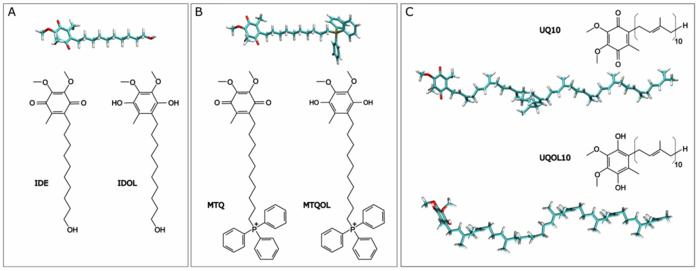Professor José Villalaín at Miguel Hernández University of Elche (UMH) is researching improved antioxidants. While oxygen is essential for life, it produces harmful free radicals that damage cells. Antioxidants, such as naturally produced ubiquinone, fight these free radicals but often lack water solubility, reducing their effectiveness. Villalaín's research aims to identify alternative antioxidant molecules that are both potent and water-soluble.
 Molecular and chemical structures of (A) IDE and IDOL, (B) MTQ and MTQOL and (C) UQ10 and UQOL10. Image Credit: Villalaín, J. (2024).
Molecular and chemical structures of (A) IDE and IDOL, (B) MTQ and MTQOL and (C) UQ10 and UQOL10. Image Credit: Villalaín, J. (2024).
The study's preliminary results indicate that the molecules under examination may have a wider range of antioxidant functions than ubiquinone, which is restricted to specific regions of the membrane. The study looks at the behavior of the molecules idebenone (IDE) and mitoquinone (MTQ) in a biomembrane that is similar to that of mitochondria, which are found in all animal cells.
Without protein transporters, ubiquinone cannot cross membranes and is insoluble in water. The study's molecules are better absorbed, more soluble, able to migrate freely across membranes, and able to transfer and accumulate.
According to Professor Villalaín, the body is indirectly impacted by free radicals. If cells are not functioning correctly, the organism cannot function, and free radicals raise the risk of that happening. Cells, however, have systems in place to regulate the production of these dangerous substances, which are created continuously.
Antioxidants assist in reducing the amount of free radicals in the body. In certain situations, preventing the production of these harmful substances can aid in the prevention of certain degenerative illnesses.
According to Professor Villalaín of the Institute of Research, Development, and Innovation in Health Biotechnology (IDiBE) at UMH, producing fewer free radicals can be achieved by placing the molecules (IDE and MTQ) in different zones and at different depths within the biological membrane. He makes it clear that the intention is to supplement ubiquinone, not to replace it, with other antioxidants that operate at various membrane levels.
A cluster of computers was needed for the experiment because the study used molecular dynamics, a "virtual simulation" method that demands a lot of processing power. The locations and interactions of the investigated molecules—both in their reduced and oxidized forms—in a membrane resembling the mitochondria were ascertained by these simulations.
UMH uses a scientific computing cluster, which is an advanced computer network under the management of the Innovation and Technological Planning Service, for this kind of research.
Source:
Journal reference:
Villalaín, J., (2024) Location and interaction of idebenone and mitoquinone in a membrane similar to the inner mitochondrial membrane. Comparison with ubiquinone 10. Free Radical Biology and Medicine. doi.org/10.1016/j.freeradbiomed.2024.06.017